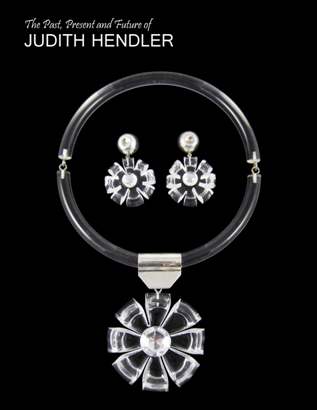
A Tale of Two Brothers Part 1 by Staff Writer for AJ Raefields
March 28, 2013
Judith Hendler: The Past, Present and Future by Erik Yang
March 28, 2013
KIM CRAFTSMEN’S JEWELRY LINES
Earrings were an extremely important part of the Kim market. In the ‘50s, prior to the hippie movement, pierced ears on teenage girls were considered radical in American culture; parents were alarmed at the prospect of their daughters coming home with such a scandalous display of adornment. Banking on the allure of this taboo, Kim produced a line of small pierced earrings for girls with rebellion in mind, as well as a large number of “pierced-look” earrings. Girls could wear these looks, and easily differentiate themselves from their parents’ generation who still wore clip-on and screw style earrings. Making fashion that made a statement remained a goal of Kim Craftsmen.
Kim became the go-to brand for stylish, affordable earrings – customers would go into stores and ask to be directed toward the Kim department. When a young shopper entered the jewelry department, previously an unwelcome environ for youths, there would be two easily accessible racks of Kim earrings to target customers. This extremely successful marketing strategy allowed department stores to sell about 1,000 pairs of earrings a day for around $3 a pair – generating the formidable sum of $3,000 in revenue, an amount higher than the rest of the entire jewelry department combined. Certain styles of Kim earrings even became generic terms: long, thin earrings were referred to as “Thin Kims” or “Slim Kims,” even if they were manufactured by another company and marketed under a different brand.
Culturally-inspired “ethnic” jewelry was another big part of the Kim market. Pieces made from hammered silver, like large hoop earrings, as well as items made from African trading beads, of which Kim was the largest importer at the time.
Always focusing on pieces that would get noticed, during the rise of the hippie movement Kim produced many items with the peace and “flower power” motif, and it incorporated the movement into its marketing tactics. Peace sign jewelry of all kinds, like peace stud earrings, as well as colorful leather belts and headbands were made. The hippie gear was a political statement, acting as a communication platform for the wearer.
Body jewelry was another venue which Kim Craftsmen felt drawn to explore. Stunning wristlets (“slave bracelets,” à la Cleopatra) and larger rings were manufactured in the late 1960s, along with cheekier items in the same vein: metal bras (referred to as bumper guards at the time) with opal nipples, belts, and impressive chainmail-like metal vests. Items like these provoked an influx of letters from appalled consumers, but Kim remained proud of their free-spirited designs.
Kim body jewelry was not intended for general public wear, so it was not widely manufactured. The intention with these designs was, again, to establish a look. The body jewelry adorning mannequins and featured in Kim displays created a distinct image for the customer to emulate. Like watching a high-fashion runway show, consumers could choose a toned-down version of a piece – a wristlet, say, or a big copper ring – and still wear the look in a comfortable way. Understanding this need in accessory options illustrates one of the Schimel brothers’ top skills: an intuitive understanding of fashion and trends.
Another contribution to fashion history is found in the evolution of Kim oversized rings. Now popular collectible pieces, they contain some of the Schimel brothers most impressive and original work. The rings combined form and texture to create a unique, larger-than-life look in every piece, another example of mass individuality.
With the revival of the art nouveau look, these metalwork rings were made from copper or other metals, in filigree or other designs, typically surrounding a large brightly-colored glass stone. The Kim rings were produced in numerous designs and the most collectible are typically metalwork stampings soldered to open shanks. These shanks are another important development in jewelry craftsmanship invented by Kim. Combining wide bands with concave centers, these shanks were used with most of the company’s larger rings allowing them to adjust to any finger size, balance well on the finger, and feel comfortable when being worn.
The rings are a prime example of Kim Craftsmen’s essence: technically impressive, individually designed, yet unquestionably feminine and wearable. Inspiration for these over-the-top rings, again, came from a desire to emphasize the generational divide. A young woman would wear these attention-grabbing rings, but her mother definitely wouldn’t – they were made to garner attention. History repeats itself as the oversized cocktail ring once again appeals to the young and fashionable making Kim vintage rings even more collectible.
DATING KIM JEWELRY
For collectors and enthusiasts, it can be hard to date the work of Kim Craftsmen because, like other prolific manufacturers of that time, many lines were privately labeled. Kim was at the forefront of this private labeling movement and although many of its pieces were unsigned, they are still very recognizable to knowledgeable collectors. Signed pieces, from 1950-1952, were marked with “C & M.” The “Kim Copper” brand was used from 1952-1958. Kim Craftsmen marks were used starting in 1955, up until 1997. Many of the rings and other pieces are marked with script “Kim” inside the ring shank.
After a big run in the 1980s and 1990s with plastic bangles, bright beaded necklaces, and other jewelry popular during that time, Kim stopped production in 1997. Over the course of close to 50 years, Kim produced in excess of 100 million pieces of jewelry – an impressive total for two brothers from Brooklyn who started in their home bending copper by hand.
While Marty passed away in 2007, Carl has continued impacting the fashion and jewelry industry as a vintage bead and jewelry component part wholesaler through a new company started in New York with his daughter Elyse Schimel, who frequently teases him about his age when the two come upon his Kim pieces (showcased frequently in museums, antique shows, and comprehensive books about period jewelry), though underneath the ribbing one can clearly see how proud she is of her father’s impact on the industry.
A PERFECT BALANCE
The face of marketing in the fashion industry has evolved over the years, from how we hear about brands and trends, to where we buy them. Jewelry manufacturing is a trade which combines creativity, commerce, attention to detail, and an overall flair for design. The beauty of the Schimels’ work lies in the way they blended these roles throughout their careers. Not only did they get their hands dirty bending copper, they founded a company with inventive methods of manufacturing and creative marketing techniques. With the dexterity to both create jewelry and navigate the business realm, Kim Craftsmen achieved the perfect balance.

Staff Writer for A J Raefields under the direction of Tracy Janik. Photos for the Kim Craftsmen features provided by A J Raefileds www.ajraefields.com.
To view more pictures from this article click here.



